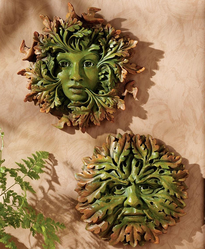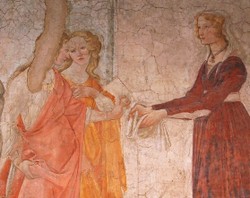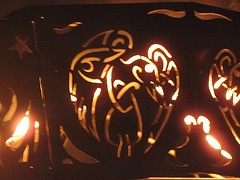Beltane is life. Beltane is fire, passion and fertility. Beltane is that bright, shining moment when barren winter is finally put to past, and all that lies ahead is summer.
The Celtic cry of Sovereignty heralds the start of the Wild Hunt. Gwyn ap Nudd pursues his elusive white hart. In Maiden form, the Goddess awakes from Her cold, crone slumber; Her young and virile Consort awaits Her coming. The Green Man mates with Mother Earth. Gwenhwyfar's May Tree blooms white flowers amid the thorns. Nature's buds begin to open. Signal the Hunt for Eostre's eggs!
In the greenwood, young men and women search all night for a Maypole. A sturdy shaft to erect in the center of their village green. They don't do much looking. Between giggling, song, and the rustling in the hedgerow, the ritual is done before the interweaving dance is ever performed in public.
Nobody asks too many questions in the dark. All is allowed on this May Eve night; when the veil between the worlds is thin, and everything in nature is in accord. And if a baby's cry pierces the air in nine months' time, then it is blessed and welcome.
Erect your bone-fires, dance between them; take your King to ride the White Horse. Enter enchanted the Greenwood Wedding. Wrap your ribbon around the pole, up and down, up and down. Choose your May Queen to parade in flowers with Her King. Tie the knot in a Beltane handfasting.
The Great Wedding of Goddess and God is enacted again; as above, so below.






















 St Tydecho's Churches in West Waleson 09/03/2014
St Tydecho's Churches in West Waleson 09/03/2014
 Goodies for an Outlander Premiere Partyon 03/06/2015
Goodies for an Outlander Premiere Partyon 03/06/2015
 Holocaust Memorial Day Interview with Rainer Höss, Grandson of Rudolf Architect of Auschwitzon 01/24/2015
Holocaust Memorial Day Interview with Rainer Höss, Grandson of Rudolf Architect of Auschwitzon 01/24/2015
 Romantic Valentine Gifts for an Outlander Fanon 01/16/2015
Romantic Valentine Gifts for an Outlander Fanon 01/16/2015



Comments
Awww! Thank you. :) I've been a High Priestess for a very long time, and fortunate to have chatted with some great people too. Plus I tore my religion to shreds for my MA, then put it back together again afterwards. Sometimes you have to do that to see how things work.
And in Wicca, you should ALWAYS question everything.
This article could have been written only by one who genuinely believes in what she is saying. The reason that I say this is that it is so full of genuine enthusiasm for the belief system that it proclaims. Truthfulness/honesty has a certain spirit/character about it. Sincerity shines through it.
No, Beltane is at this time, with Samhain in the autumn, but right at the end of it. I really enjoyed Rosemary Sutcliffe's books.
I remember Rosemary Sutcliffe's books, where her characters jumped through the Beltane fires. At least I think it was the Beltane fires and not the Samhain ones. For some reason I always had Beltane at Autumn Equinox though it makes more sense for it to be Spring.
It sounds like your Shamans used it in the same way that the British did. Beltane is about cleansing too. The Celts used to have two fires, which they drove their cattle between for blessing. I've jumped over plenty of Beltane fires myself for the same reason.
Burning stuff has many effects and side-effects. It' helps us cleaning the mess and create some space for something new. It gives us warmth (nights in April can be still pretty cold). It can make us dizzy (several tribes use this to inspire shamans). We (and many other nations) used bonfires to warn people in neighborhood against invasions (in our case Turks). And there are of course smoke signals ... Fire has so many powers!
The original bonfires involved burning bones, that's why we call them bonfires. It's not a typo. <3
And glad that you liked it. :D
Lovely article. Bone-Fires? In the first paragraph.
I so did. :) I did have much more on the Statue of Liberty in there, but it wasn't really that relevant, so I took it out. I've put it aside for a future article, as I think I promised you one on that ages ago.
I hope you had as much fun writing this as I has reading it.
:P